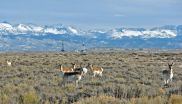(Press-News.org) One of North America's last remaining long-distance land migrations, better known as the Path of the Pronghorn, is being threatened by a mosaic of natural gas field development, highway traffic, and fencing in the upper Green River Basin, according to the Wildlife Conservation Society. WCS scientists used a model traditionally applied to identify resource related stopovers for migrating animals in order to identify impediments to migration of pronghorn.
The long-distance travels of the fleet-footed pronghorn through this part of the Greater Yellowstone Ecosystem was the focus of a high-tech effort to identify impediments inside the animal's migratory corridors based on how pronghorn behave when confronting a potential obstacle.
The study titled "Identifying Impediments to Long-Distance Mammal Migrations" appears in the online version of the journal Conservation Biology. The authors are: Renee Seidler, Ryan Long, Joel Berger, Scott Bergen, and Jon Beckmann.
"Long-distance mammal migration is in serious peril around the globe. Highways with dense traffic and housing developments might present obvious obstacles in need of mitigation, but in some areas, addressing threats requires more than simple observation and intuition. Insight into animal behaviour using technical applications can provide precise understanding of the mechanisms behind the animal movement," said WCS researcher Renee Seidler, lead author of the paper. "Our findings of how pronghorn move through the landscape give a solid foundation from which to formulate effective solutions for threatened migrations."
The pronghorn of the Greater Yellowstone Ecosystem have already been the focus of several efforts to minimize the effects of development on their migration, which can extend over 170 miles annually between the upper Green River Basin and the Jackson Hole area and Grand Teton National Park in Wyoming. In 2008, part of this migration route was afforded protection by the Bridger-Teton National Forest. In 2012, a series of over- and underpasses with guide fencing were constructed by the Wyoming Department of Transportation to facilitate the movements of pronghorn and other wildlife across US Highway 191 at Trapper's Point. The migration route, however, still remains under threat from other impediments such as development, fences, and traffic on roads along unprotected stretches.
The latest research effort elucidated how pronghorn were reacting to environmental variables along the migration corridor. From 2005 to 2009, the scientists captured 250 female pronghorn antelope with nets deployed from helicopters during the winter months; the animals were then fitted with GPS-collars and released, allowing scientists to pinpoint the animals eight times a day. The team also conducted a detailed analysis of the migratory landscape via satellite imagery, including two gas fields in various stages of development.
The researchers then used a two-stage analysis to determine if pronghorn used stopover sites to gather resources or if the stopovers were generated by a perceived impediment. The collared pronghorn spent 78 percent of their time in stopovers during the spring migration. During their migration, they avoided the most densely developed natural gas field areas, in accord with a previous WCS study of pronghorn habitat use on winter range in the region. Highways presented another difficulty for migrating pronghorn, especially along Highway 191 north of Farson, Wyoming where the road is bordered by a woven-wire fence (an impenetrable barrier for pronghorn).
The team discovered that pronghorn that approached migration bottlenecks with high traffic volumes, fences, and land development—such as those along US Highway 191—used a stopover before crossing the highway and, notably, did not select high quality forage on either side of the highway. Additionally, they avoided shrub habitat—an important food resource for pronghorn—when approaching the highway, but then began selecting for shrubs again after crossing. By contrast, pronghorn migrating across US Highway 189, where bottlenecks were absent, traffic densities were lower, and fences had been modified to accommodate wildlife, did make use of high quality food sources on both sides of the road. The effects of bottlenecks on pronghorn movements and foraging behaviours, the authors maintain, could have a significant impact on the fitness of migrating animals.
"The insights provided by this study will help us build on the successes of recently constructed wildlife crossing structures around Trapper's Point." said Dr. Jon Beckmann, Connectivity Initiative Coordinator of WCS's North America Program and lead on the pronghorn project. "A better understanding of how pronghorn use habitat during their migrations, and the factors that may impact their ability to move through the landscape, will enable state and federal agencies and conservation groups to ensure a future for North America's fastest land mammal."
INFORMATION:
To access the study, go to:
http://onlinelibrary.wiley.com/doi/10.1111/cobi.12376/full
Study identifies gauntlet of obstacles facing migrating pronghorn in greater Yellowstone
Five-year study identifies dense natural gas field developments, highways, and fencing as threats to one of North America's last great long-distance mammal migrations
2014-09-25
ELSE PRESS RELEASES FROM THIS DATE:
New research outlines promising therapies for small cell lung cancer
2014-09-25
CLEVELAND: Two recently published studies by a research team at University Hospitals (UH) Case Medical Center Seidman Cancer Center have the potential to advance treatments for small cell lung cell cancer (SCLC). This aggressive form of lung cancer has seen no treatment advances in 30 years and "is a disease in urgent need of new drug therapies," write the study's authors.
"In small cell lung cancer, which impacts about 30-40,000 people each year in the United States, there has been no therapeutic progress and very little research," says Afshin Dowlati, MD, lead author ...
Coping techniques help patients with COPD improve mentally, physically
2014-09-25
DURHAM, N.C. -- Coaching patients with chronic obstructive pulmonary disease to manage stress, practice relaxation and participate in light exercise can boost a patient's quality of life and can even improve physical symptoms, researchers at Duke Medicine report.
In a study published online Sept. 25, 2014, in the journal Psychosomatic Medicine, Duke researchers examined how telephone-based coaching could help patients with chronic obstructive pulmonary disease, or COPD, a progressive disease that limits airflow in the lungs.
About 15 million Americans have COPD, and ...
Solar cell compound probed under pressure
2014-09-25
Washington, D.C.— Gallium arsenide, GaAs, a semiconductor composed of gallium and arsenic is well known to have physical properties that promise practical applications. In the form of nanowires and nanoparticles, it has particular potential for use in the manufacture of solar cells and optoelectronics in many of the same applications that silicon is commonly used.
But the natural semiconducting ability of GaAs requires some tuning in order to make it more desirable for use in manufacturing these types of products. New work from a team led by Carnegie's Alexander Goncharov ...
A wriggly solution to a first-world problem
2014-09-25
Australian researchers have achieved groundbreaking results in a clinical trial using hookworms to reduce the symptoms of celiac disease.
The results are also good news for sufferers of other inflammatory conditions such as asthma and Crohn's disease.
In the small trial run over a year, 12 participants were each experimentally infected with 20 Necator americanus (hookworm) larvae.
They were then given gradually increasing doses of gluten – beginning with just one-tenth of a gram per day (the equivalent of less than a one-inch segment of spaghetti) and increasing in ...
Study finds global sea levels rose up to 5 meters per century at the end of the last 5 ice ages
2014-09-25
Land-ice decay at the end of the last five ice-ages caused global sea-levels to rise at rates of up to 5.5 metres per century, according to a new study.
An international team of researchers developed a 500,000-year record of sea-level variability, to provide the first account of how quickly sea-level changed during the last five ice-age cycles.
The results, published in the latest issue of Nature Communications, also found that more than 100 smaller events of sea-level rise took place in between the five major events.
Dr Katharine Grant, from the Australian National ...
Cryptogenic strokes may find explanation in the heart
2014-09-25
More than half of the patients who have suffered a stroke with no well-defined aetiology have an enlarged left atrial appendage of the heart, according to a Finnish study. The results indicate that the enlargement of the left atrial appendage may be an independent risk factor of strokes with cardiac origin.
Mr Mikko Taina, Licentiate of Medicine, presented the results in his doctoral thesis at the University of Eastern Finland.
Stroke is the leading cause of long-term disability and a major burden on health-care resources worldwide. Stroke is responsible for 10 per ...
Osteoarthritis of the hip: Appropriate exercise therapy can alleviate symptoms
2014-09-25
Osteoarthritis of the hip is a progressive degenerative disorder affecting the hip joints, which affects one in 10 adults. The symptoms range from pain after intense joint loading to morning pain/stiffness and impaired mobility in everyday life. To date, no cure exists. Appropriate exercise therapy can, however, delay progression of the disease and alleviate symptoms, as shown in a randomized controlled study reported by Inga Krauß et al in Deutsches Ärzteblatt (Dtsch Arztebl Int 2014; 111: 592–9).
The physicians treated patients with hip osteoarthritis according to the ...
Human papilloma virus vaccination provides long-term protection
2014-09-25
Every year, 11.2 of every 100 000 women in Germany develop cervical cancer. Persistent infection with a high-risk human papillomavirus (HPV) type is a necessary prerequisite for the development of dysplasia and neoplasia of the cervix. HPV vaccination has been a subject of heated debate since it was incorporated into the vaccination recommendations of the German Standing Committee on Vaccination (STIKO) in 2007. This edition of Deutsches Ärzteblatt International (Dtsch Arztebl Int 2014; 111: 584–91) reveals that Yvonne Deleré of Berlin's Robert Koch Institute et al. have ...
Brains not recognizing an angry expression
2014-09-25
Inattention, hyperactivity, and impulsive behavior in children with ADHD can result in social problems and they tend to be excluded from peer activities. They have been found to have impaired recognition of emotional expression from other faces. The research group of Professor Ryusuke Kakigi of the National Institute for Physiological Sciences, National Institutes of Natural Sciences, in collaboration with Professor Masami K. Yamaguchi and Assistant Professor Hiroko Ichikawa of Chuo University first identified the characteristics of facial expression recognition of children ...
Chemists recruit anthrax to deliver cancer drugs
2014-09-25
CAMBRIDGE, MA -- Bacillus anthracis bacteria have very efficient machinery for injecting toxic proteins into cells, leading to the potentially deadly infection known as anthrax. A team of MIT researchers has now hijacked that delivery system for a different purpose: administering cancer drugs.
"Anthrax toxin is a professional at delivering large enzymes into cells," says Bradley Pentelute, the Pfizer-Laubauch Career Development Assistant Professor of Chemistry at MIT. "We wondered if we could render anthrax toxin nontoxic, and use it as a platform to deliver antibody ...
LAST 30 PRESS RELEASES:
Numbers in our sights affect how we perceive space
SIMJ announces global collaborative book project in commemoration of its 75th anniversary
Air pollution exposure and birth weight
Obstructive sleep apnea risk and mental health conditions among older adults
How talking slows eye movements behind the wheel
The Ceramic Society of Japan’s Oxoate Ceramics Research Association launches new international book project
Heart-brain connection: international study reveals the role of the vagus nerve in keeping the heart young
Researchers identify Rb1 as a predictive biomarker for a new therapeutic strategy in some breast cancers
Survey reveals ethical gaps slowing AI adoption in pediatric surgery
Stimulant ADHD medications work differently than thought
AI overestimates how smart people are, according to HSE economists
HSE researchers create genome-wide map of quadruplexes
Scientists boost cell "powerhouses" to burn more calories
Automatic label checking: The missing step in making reliable medical AI
Low daily alcohol intake linked to 50% heightened mouth cancer risk in India
American Meteorological Society announces Rick Spinrad as 2026 President-Elect
Biomass-based carbon capture spotlighted in newly released global climate webinar recording
Illuminating invisible nano pollutants: advanced bioimaging tracks the full journey of emerging nanoscale contaminants in living systems
How does age affect recovery from spinal cord injury?
Novel AI tool offers prognosis for patients with head and neck cancer
Fathers’ microplastic exposure tied to their children’s metabolic problems
Research validates laboratory model for studying high-grade serous ovarian cancer
SIR 2026 delivers transformative breakthroughs in minimally invasive medicine to improve patient care
Stem Cell Reports most downloaded papers of 2025 highlight the breadth and impact of stem cell research
Oxford-led study estimates NHS spends around 3% of its primary and secondary care budget on the health impacts of heat and cold in England
A researcher’s long quest leads to a smart composite breakthrough
Urban wild bees act as “microbial sensors” of city health.
New study finds where you live affects recovery after a hip fracture
Forecasting the impact of fully automated vehicle adoption on US road traffic injuries
Alcohol-related hospitalizations from 2016 to 2022
[Press-News.org] Study identifies gauntlet of obstacles facing migrating pronghorn in greater YellowstoneFive-year study identifies dense natural gas field developments, highways, and fencing as threats to one of North America's last great long-distance mammal migrations




